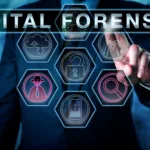Digital Forensics
Digital forensics is the process of collecting, preserving, analyzing, and presenting electronic data in a manner that is admissible as evidence in a court of law

Unlocking Digital Evidence - Your Trusted Forensic Partner!
What is Digital forensics
Digital forensics is a branch of forensic science that involves the collection, preservation, analysis, and presentation of electronic data. It can be used as evidence in a court of law. This field typically deals with digital devices such as computers, mobile phones, digital cameras, and other electronic devices. It may also contain information relevant to a criminal investigation or civil lawsuit.
Mobile device forensics, database forensics, and network forensics are all subsets of digital forensics, which is a multidisciplinary field. It entails gathering, analysing, and preserving electronic evidence, such as data from mobile devices and storage devices. Professionals in this sector use advanced tools to extract and evaluate digital information, confirming the evidence’s integrity and validity. Digital forensics has grown in prominence, with organisations such as the National Hi-Tech Crime Unit playing an important part in investigating cybercrime. Furthermore, the emergence of cloud computing has complicated the procedure because digital forensics experts must deal with data stored on faraway servers.
The main goal of digital forensics is to gather and analyze digital evidence in a way that is admissible in court and that can help investigators determine how a crime was committed and identify the person or people responsible. This can involve analyzing data from hard drives, recovering deleted files, analyzing network traffic, and examining metadata to determine who accessed a particular file and when.
Benefits of performing Digital Forensics
- Cybercrime investigation: Digital forensics can assist law enforcement authorities in investigating a variety of cybercrimes such as hacking, phishing, identity theft, and cyber espionage. Digital forensics techniques can be used by investigators to extract evidence from computers, mobile devices, and networks in order to identify suspects, trace the origin of attacks, and convict criminals.
- Intellectual property theft: Cases of intellectual property theft, such as copyright infringement, patent breaches, and trade secret theft, can be investigated using digital forensics. Forensic experts can examine digital data to determine whether a specific person or organisation has stolen or misappropriated intellectual property.
- Employee misconduct: Employers can utilise digital forensics to examine employee wrongdoing such as data theft, unauthorised access to company networks, and violation of confidentiality. Employers can identify employees accountable for misconduct and take necessary disciplinary action by analysing digital evidence.
- Litigation: In civil litigation, digital forensics can be used to obtain evidence connected to a wide range of legal challenges. It also includes intellectual property disputes, breach of contract, and fraud. Lawyers can use digital evidence to assist them secure settlements and support their clients’ claims in court.
- Incident response: Digital forensics can be used to analyse security issues like data breaches or network invasions and pinpoint the source of the assault. By analyzing digital evidence, incident response teams can develop a plan to contain the attack, remediate any damage, and prevent future incidents.
Our Methodology
Steps which we use in-order to achieve goal

Identification
Finding out all the evidences

Preservation
This is done in-order to prevent people from possibly tampering

Analysis
Perform analysis to reconstruct and draw out conclusion

Documentation
Keep a documented record of all the data



We provide
- Operational support
- Guidance
- Capacity building
FAQ
Evidence is collected either when the investigators seize or maintain the original evidence. Detailed info can be find in this link.
Computer forensics tools are applications or software that are used to investigate digital devices and reconstruct events. Common tools are:- Autopsy/The Sleuth Kit, Bulk Extractor, X-Ways Forensics and many more. You can find tools and information regarding tools here.
- Media forensics: It includes identification, collection, analysis and presentation of audio, video and image evidences during the investigation process.
- Cyber forensics: It is the branch that deals with identification, collection, analysis and presentation of digital evidences during the investigation of a cyber crime.
- Mobile forensics: It deals with the investigation of a crime committed through a mobile device like mobile phones, GPS device, tablet, laptop.
- Software forensics: It investigates of a crime related to software’s only.

